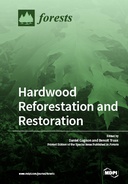Explore

Hardwood Reforestation and Restoration
Daniel Gagnon and Benoit Truax
2019
0 Ungluers have
Faved this Work
Login to Fave
Hardwood-dominated temperate forests (mostly in Eastern North America, Europe, North East Asia) provide valuable renewable timber and numerous ecosystem services. Many of these forests have been subjected to harvesting or conversion to agriculture, sometimes over centuries, that have greatly reduced their former extent and diversity. Natural regeneration following harvesting or during post-agricultural succession has often failed to restore these forests adequately. Past harvesting practices and the valuable timber of some species have led to a reduction in their abundance. The loss of apex predators has caused herbivore populations to increase and exert intense browsing pressure on hardwood regeneration, often preventing it. Particularly important are fruit, nut and acorn bearing species, because of their vital role in forest food webs and biodiversity. Restoring hardwood species to natural forests in which they were formerly more abundant will require a number of forest management actions (e.g., resistant hybrids, deer exclosures/protectors, enrichment planting, underplanting, etc.). Similarly, reforesting areas that were once natural forests will also require new silvicultural knowledge. Global warming trends will intensify the need for interventions to maintain the diversity and function of temperate hardwood forests, as well as for increase hardwood reforestation.
This book is included in DOAB.
Why read this book? Have your say.
You must be logged in to comment.
Rights Information
Are you the author or publisher of this work? If so, you can claim it as yours by registering as an Unglue.it rights holder.Downloads
This work has been downloaded 355 times via unglue.it ebook links.
- 40 - pdf (CC BY-NC-ND) at Unglue.it.
Keywords
- abandoned agricultural field
- Agroforestry
- assisted migration
- avian guilds
- Bioclimatic niche
- Biological diversity
- Carya cordiformis (Wangenh.) K. Koch
- Central Hardwood Forest region
- Competition
- Cultural Diversity
- deer abundance
- deer browsing
- deer herbivory
- Durango
- Ecosystem services
- enrichment planting
- facilitation
- Fagaceae species
- floristic quality index
- forest diversity
- Forest regeneration
- Forest restoration
- growth efficiency index
- hardwood restoration
- hardwoods
- herbicide effects
- indicators
- invasive plants
- Inventory
- Juglans nigra
- Juglans nigra L.
- MaxEnt
- Mexican tree species
- Monitoring
- native americans
- native mixed forests
- nitrate
- non-parametric correlation
- non-timber forest products
- oak regeneration
- phosphorus
- Pinus strobus
- Pinus strobus L.
- precision restoration
- predation
- protected landscape area
- Quercus macrocarpa
- Quercus rubra
- Quercus rubra L.
- riparian forest restoration
- seed predation
- seedling establishment
- shelterwood
- soil disturbance
- species composition
- sub-tropical hardwoods
- sugar maple
- thema EDItEUR::P Mathematics and Science::PS Biology, life sciences
- tolerance
- tree plantation
- tree selection
- tree shelter
- tree vigor
- understorey
- unmanaged forest
- vegetation management
- weed control
- wildfire
- yellow birch
Links
DOI: 10.3390/books978-3-03897-731-5Editions


